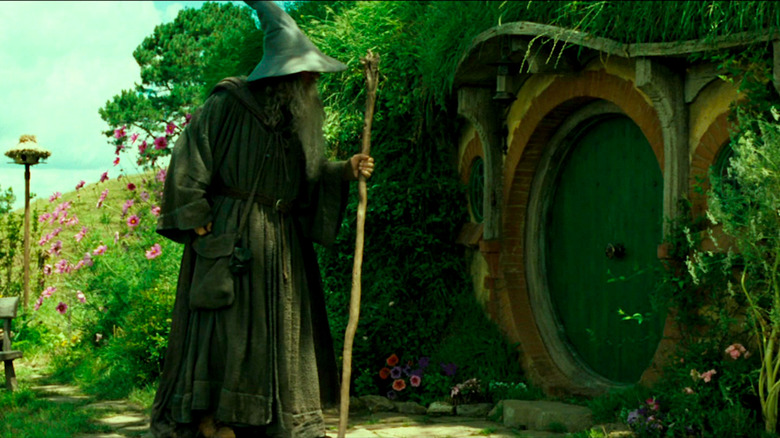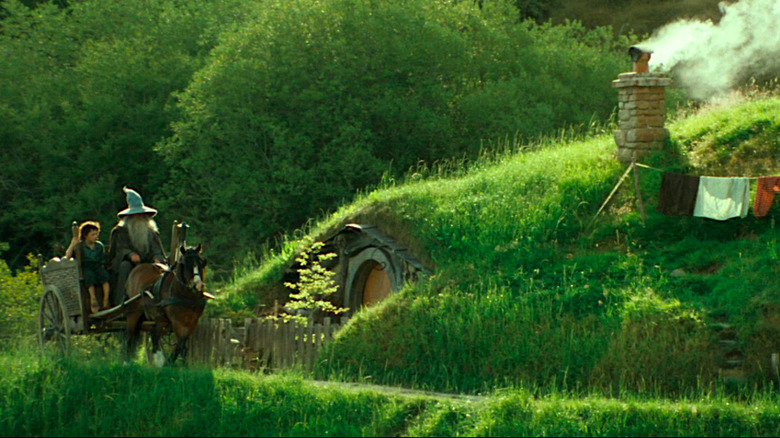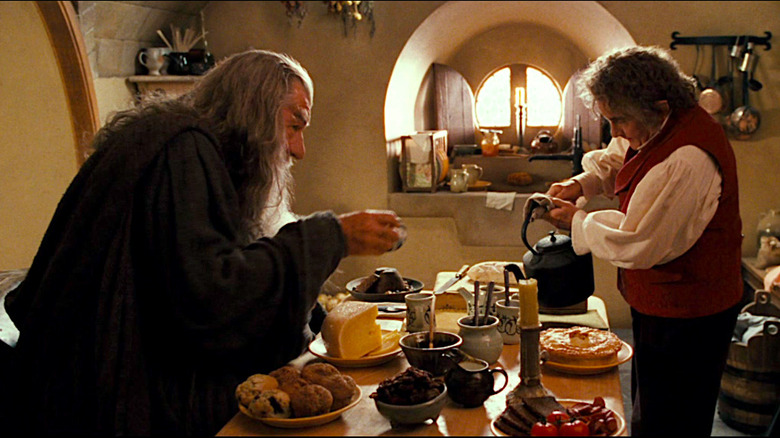Building The Hobbiton Set For Lord Of The Rings Was A Massive Undertaking
If you spend any time at all on Instagram, there's no doubt you've stumbled across cottagecore at some point. Images usually boast flowy, linen dresses and dried flowers hanging in bunches from wooden rafters. It's a vibe that is meant to capture the delicacy and coziness of living in a small cabin in the woods. Those who abide by the cottagecore lifestyle probably like things like beekeeping and hand-sewing their own quilts and bloomers. Their idea of a good time is spending the afternoon wading waist deep into the nearest creek or lying lazily on the shore reading poetry under the shade of a chestnut tree. It's a relaxed lifestyle, perhaps similar to the Danish tradition of hygge (which also has had its moment in the trendy spotlight), and to be perfectly honest, everything about it feels like something straight out of "The Lord of the Rings." So much so that Hobbitcore might be a more appropriate name for a lifestyle that seems to make its statement by being all about the coze.
If, like me, you have a strong obsession with Hobbits and their way of life, then you no doubt want nothing more than to live in a Hobbit hole of your own creation. Imagine it. Waking up in a cozy, multi blanket bed and getting up to make yourself a nice breakfast of tea and pastries, only to follow it with a delicious second breakfast of a little fruit and jam on toast. Perhaps you spend the days lazing in the sunshine on one of the many hills of Hobbiton, smoking pipe weed and watching the bees pollinate the flowers. Time is of no concern here, and you are entirely at peace.
If I could, I would pay a lot of money to build my own Hobbit hole, and each time I settle in to watch Peter Jackson's "The Lord of the Rings" trilogy, I find myself yearning for that simple Hobbit life in their cozy little homes. They look so comfortable and habitable on screen, but just what did it take to create the village of Hobbiton for the films, and is there any hope of building a Hobbit hole that's all my own?
Finding the perfect place for Hobbiton
In J.R.R. Tolkien's novels, the Shire is often described as being an inland town with plenty of rolling hills and green pastures for its inhabitants to enjoy. When looking for this very specific landscape to build the Shire for the films, Peter Jackson and his crew searched everywhere throughout New Zealand. What they eventually settled on was an area of land located in a rural part of the country. The land mimicked Tolkien's descriptions perfectly, but in order to actually use the land for the films, Screen Rant reports that Jackson's film crew had to first convince the farmer's who actually owned the land that it would be a good use of their land and their time.
Eventually, the farmers agreed and the Shire began coming to life. The Green Roofs website states that in all, Hobbiton encompasses 12 acres in the northern part of New Zealand, and it shares its home with the Alexander sheep farm where both cattle and sheep are raised. After the initial trilogy was completed, most of Hobbiton was dismantled, rending the village unusable. But when it became clear that there were going to be prequels (i.e. "The Hobbit: An Unexpected Journey," etc.), the decision was made to rebuild Hobbiton, only this time, the small, humble village would be a permanent addition to the Alexander sheep farm.
Today, if you are lucky, you can get a tour of this semi-real version of Hobbiton (sadly, only one of the houses is actually enterable) and experience the Shire firsthand. It's basically like the Galaxy's Edge version of theme parks for Middle Earth fanatics, and I for one, am dying to go.
How do you bring an imaginary town to life?
The entire process of building Hobbiton the first time took a whole year to complete. That's a long time to invest in a small village that would eventually only be used sparingly throughout the course of all three films. However, Hobbiton is a massively important landmark in the realm of Middle Earth. It represents everything that is pure and good in these character's lives, and so it needed to be done exactly right.
The Green Roofs website describes how the crew responsible for bringing the Shire to life built 37 Hobbit holes (which has now been upgraded to 44), and to make their exteriors seem cozy and well-loved, they were constantly bringing in native plants and shrubs to help define the Hobbit's love of gardening. The houses themselves are made up of "stone, concrete and brick, covered with native grasses and clovers and surrounded by gardens and orchards farmed for fresh produce," and each home is meant to convey the personality traits and occupations of the imagined Hobbits that live there. It took 70 set designers to bring the Shire to life, and the amount of thought that went in to making sure Hobbiton was accurate is genuinely astounding. Even the bricks were made special for the construction of the homes, and the wood was aged to give the setting a rustic, lived-in feel.
In an interview for The Independent, art director Dan Hennah talked about how Jackson "didn't just want to use furniture you got from the supermarket. Every single piece was our work. The fabrics were homespun, we established our own pottery, we made the glass, the cutlery in Bilbo's house was all made. There was nothing in the films that wasn't specifically made." This highly labor intensive decision paid off in the end because the world of the Shire is one of the most unique and breathtaking set designs to ever grace the screen. Even though the process of creating this part of Tolkien's world was a lot of work, it was totally worth it in the end. Unfortunately for the fans, there are no official concrete plans available for how to build your own Hobbit hole, but that doesn't mean people haven't tried (and succeeded) in making that cozy life real.


